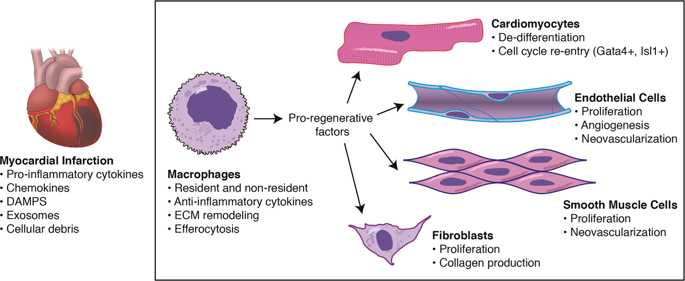当前位置:
X-MOL 学术
›
Exp. Mol. Med.
›
论文详情
Our official English website, www.x-mol.net, welcomes your
feedback! (Note: you will need to create a separate account there.)
Macrophages in cardiac repair: Environmental cues and therapeutic strategies.
Experimental & Molecular Medicine ( IF 9.5 ) Pub Date : 2019-12-19 , DOI: 10.1038/s12276-019-0269-4 Geoffrey de Couto 1
Experimental & Molecular Medicine ( IF 9.5 ) Pub Date : 2019-12-19 , DOI: 10.1038/s12276-019-0269-4 Geoffrey de Couto 1
Affiliation

|
Mammals, in contrast to urodeles and teleost fish, lose the ability to regenerate their hearts soon after birth. Central to this regenerative response are cardiac macrophages, which comprise a heterogeneous population of cells with origins from the yolk sac, fetal liver, and bone marrow. These cardiac macrophages maintain residency in the myocardium through local proliferation and partial replacement over time by circulating monocytes. The intrinsic plasticity of cardiac macrophages in the adult heart promotes dynamic phenotypic changes in response to environmental cues, which may either protect against injury or promote maladaptive remodeling. Thus, therapeutic strategies promoting myocardial repair are warranted. Adult stromal cell-derived exosomes have shown therapeutic promise by skewing macrophages toward a cardioprotective phenotype. While several key exosomal non-coding RNA have been identified, additional factors responsible for cardiomyocyte proliferation remain to be elucidated. Here I review cardiac macrophages in development and following injury, unravel environmental cues modulating macrophage activation, and assess novel approaches for targeted delivery.
中文翻译:

心脏修复中的巨噬细胞:环境线索和治疗策略。
与 urodeles 和硬骨鱼相比,哺乳动物在出生后不久就失去了再生心脏的能力。这种再生反应的核心是心脏巨噬细胞,它包含来自卵黄囊、胎肝和骨髓的异质细胞群。这些心脏巨噬细胞通过局部增殖和随着时间的推移被循环单核细胞部分替代而维持在心肌中的驻留。成人心脏中心脏巨噬细胞的内在可塑性促进了响应环境线索的动态表型变化,这可以防止损伤或促进适应不良的重塑。因此,促进心肌修复的治疗策略是必要的。通过使巨噬细胞偏向心脏保护表型,成人基质细胞衍生的外泌体显示出治疗前景。虽然已经鉴定了几个关键的外泌体非编码 RNA,但导致心肌细胞增殖的其他因素仍有待阐明。在这里,我回顾了发育中和损伤后的心脏巨噬细胞,揭示了调节巨噬细胞活化的环境线索,并评估了靶向递送的新方法。
更新日期:2019-12-19
中文翻译:

心脏修复中的巨噬细胞:环境线索和治疗策略。
与 urodeles 和硬骨鱼相比,哺乳动物在出生后不久就失去了再生心脏的能力。这种再生反应的核心是心脏巨噬细胞,它包含来自卵黄囊、胎肝和骨髓的异质细胞群。这些心脏巨噬细胞通过局部增殖和随着时间的推移被循环单核细胞部分替代而维持在心肌中的驻留。成人心脏中心脏巨噬细胞的内在可塑性促进了响应环境线索的动态表型变化,这可以防止损伤或促进适应不良的重塑。因此,促进心肌修复的治疗策略是必要的。通过使巨噬细胞偏向心脏保护表型,成人基质细胞衍生的外泌体显示出治疗前景。虽然已经鉴定了几个关键的外泌体非编码 RNA,但导致心肌细胞增殖的其他因素仍有待阐明。在这里,我回顾了发育中和损伤后的心脏巨噬细胞,揭示了调节巨噬细胞活化的环境线索,并评估了靶向递送的新方法。




















































 京公网安备 11010802027423号
京公网安备 11010802027423号